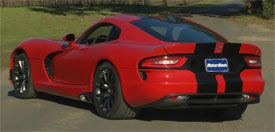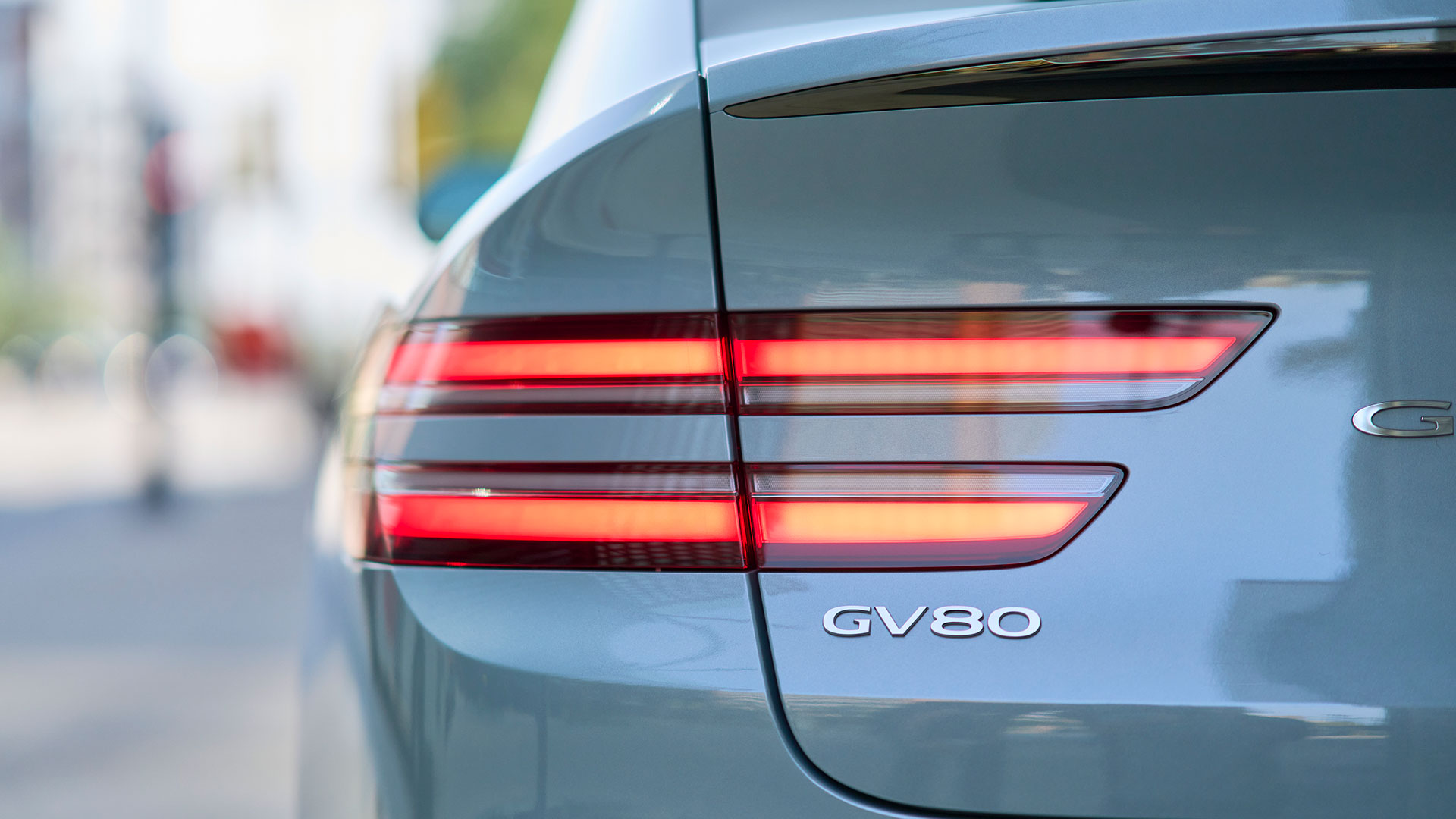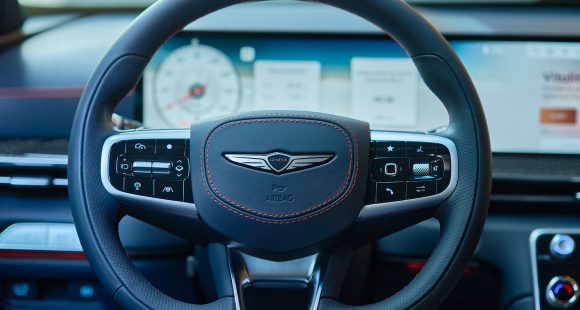2013 SRT Viper
By now you’ve heard that the Viper sports car has been reincarnated; this time wearing SRT badging rather than Dodge. Early reports are that this is a kinder and gentler Viper, to which die hards respond, “Say it isn’t so!” Well has the snake truly been charmed? Well we’ll be the judge of that. And, we here at our favorite road course to find out!
Yes, the 2013 SRT Viper may no longer be a Dodge, but no matter what you call it, the only place to really experience a Viper is at the track, and while we’ve applied rubber to just about every major road course in the country, it’s our annual winter trek to Savannah’s two-mile Roebling Road Raceway that we look forward to the most.
 We’ve driven every previous generation Viper here and they didn’t as much slither through these 9 high speed turns as pulverize them into submission. Well, is this new Viper indeed a kinder and gentler reptile?
We’ve driven every previous generation Viper here and they didn’t as much slither through these 9 high speed turns as pulverize them into submission. Well, is this new Viper indeed a kinder and gentler reptile?
Well, yes and no. It certainly felt a lot more unwavering on our initial laps and it had no problem holding a line. But, it’s not exactly sedate either, there’s still plenty of naughtiness to go around.
It really all depends on what traction control mode you’re operating with… …wait, traction what? Yes, the new Viper has an electronic nanny. I guess it was inevitable. But, you can totally disable it for the true Viper experience. And if you plan on taking in lots of track days, we’d suggest stepping up to the GTS, as it offers additional modes for the Stability Control and a 2-mode suspension system with Bilstein DampTronic Select shock absorbers.
The suspension design is thoroughly revised and lightened with a wider front track and stiffer frame to support it. We immediately noticed a much improved eagerness to turn in; though steering with the throttle is still where the fun’s at! You can further the insanity by opting for the SRT Track Package which shaves weight further and increases grip with race compound Pirelli P Zero Corsa tires on ultra-lightweight wheels, 18’s in the front, 19’s in the rear.
 There’s still a nasty amount of power, but it does feel better mannered than before. And there’s still 8.4-liters worth of V10 under the hood, although it’s also gotten lighter as well as stronger. Horsepower is up to 640, with torque coming in at 600 lb-ft. It’s one of our all-time favorite rhythm sections and we’re glad to hear it rocking out once again. Transmission remains Tremec 6-speed manual only, but it likewise is improved, working far more smoothly than before.
There’s still a nasty amount of power, but it does feel better mannered than before. And there’s still 8.4-liters worth of V10 under the hood, although it’s also gotten lighter as well as stronger. Horsepower is up to 640, with torque coming in at 600 lb-ft. It’s one of our all-time favorite rhythm sections and we’re glad to hear it rocking out once again. Transmission remains Tremec 6-speed manual only, but it likewise is improved, working far more smoothly than before.
Combined, they spring the Viper to 60 in just 3.5-seconds! And things have gotten a lot easier off the line thanks to standard Launch Control. Once you get rolling though, it’s down the quarter mile with a smile and a prayer as you struggle for traction on the way to hitting 128 miles-per-hour in 11.5-seconds. The brakes, which didn’t feel that impressive on the street, came alive at the track and showed no signs of fading.
If you spent any time in previous Vipers, unless you were on the track, the experience just wasn’t that pleasant. Jarring is a good word. Well that’s no longer the case. The new Viper is much more enjoyable to drive than before, though never use the word soft. You’ll definitely want to spend more time behind the wheel. So, you may want to keep a lawyer on retainer just in case.
 And realizing that people who want to shell out six figures for a car with a barebones interior are few, Chrysler made the biggest changes of all inside the new Viper’s cabin. There’s more sound-deadening, nicer leather, and a much better audio system. Plus cruise control, available touch screen navigation, and even 14.7 cubic-ft. of cargo space to store your extra testosterone under the rear hatch.
And realizing that people who want to shell out six figures for a car with a barebones interior are few, Chrysler made the biggest changes of all inside the new Viper’s cabin. There’s more sound-deadening, nicer leather, and a much better audio system. Plus cruise control, available touch screen navigation, and even 14.7 cubic-ft. of cargo space to store your extra testosterone under the rear hatch.
Exterior design is a modern version of the original, a little more serious and a little less cartoonish, with every scoop and vent having a real purpose. Here too weight reduction was a goal, thanks to aluminum and even some carbon fiber body panels.
With all of those upgrades, an upgrade in price was expected, but we still think the Viper is well worth its $99,390 price tag. Jump to the GTS for just $23,000 more.
Quite simply, the 2013 SRT Viper delivers, and we want one bad. That’s why it a Drivers’ Choice Dream Machine. Indeed, it’s now refined interior and huge improvement in everyday livability might be just be what it takes to convince your spouse on buying one too. We mean it when we say Best! Viper! Ever!
Specifications
- Engine: 8.4-liters
- Horsepower: 640
- Torque: 600 lb-ft.
- 0-60 mph: 3.5 seconds
- 1/4 mile: 11.5 seconds @ 128 mph
2025 Audi SQ7
Audi…Still Bringing The V8 Power
Like every other luxury-minded European carmaker, Audi has a full portfolio of utility vehicles to choose from, including big ones like the Q7 and big fast ones like this SQ7. 2025 brings a host of updates for this still V8-powered prestige performer, and we can’t wait to check it all out.
Audi’s largest SUV, the seven-passenger Q7, launched way back in 2007; but it wasn’t until 2020, well into its second generation, that it got the proper high-performance treatment with an SQ7 version. Well, it’s time for the 2025 model year, and while the SQ7 is still rockin’ through its second gen, Audi is cranking it up when it comes to style and tech.
All Q7s get revised styling for 2025 with modernized front and rear fascias, along with updated and now customizable LED lighting. Up front, lower aero treatments are slightly reshaped, and Audi’s Singleframe grille gets new patterns that are unique for Q7 and SQ7. In back, there’s a more aggressive looking rear diffuser that better integrates some new exhaust tips. And rounding it out are some fresh color choices and five new wheel designs. In addition to the unique grille, SQ7s feature additional aero treatments throughout, quad exhaust tips, and larger brakes behind 21-inch wheels, which can be optioned up to these 22s.
Tech updates come by way of better smartphone integration into the MultiMedia Interface, with the ability to not only use more third-party apps but download them directly to the vehicle. It’s all done through Audi’s latest MMI setup which features an in-dash infotainment touchscreen, a smaller touch panel just below for climate controls and additional functions such as handwriting recognition, and, of course, a 12.3-inch virtual cockpit for the driver.
There are some minor material upgrades throughout, and more uniqueness to coincide with trim levels; plus, some new available packages to further customize the space. All Q7s are outfitted for seven passengers with plenty of adult-size room in the second-row bench; the third row, it’s best left to the kids.
This thing is quick, like EV quick, taking off much faster than you’re expecting.
All of that is indeed great, but the star of this show remains what’s under the SQ7’s hood. Oh yeah, Audi still believes in V8s, and this is a great one, the same 4.0-liter twin-turbo engine used by Porsche and even Lamborghini in their SUVs. Here in Audi tune, it delivers 500 horsepower along with 568 lb-ft of torque. And wow this thing is quick, like EV quick, taking off much faster than you’re expecting. At Mason Dixon Dragway it hooked up easily, pounced off the line, and pulled hard the whole way down the strip. We hit 60 in a mere 3.8 seconds.
Audi keeps the Tiptronic name alive for their eight-speed automatic transmission and it slams through the first few gears quite aggressively, easing off a little in higher ones. That V8 made all the right noises throughout the quarter-mile but without being too loud. 12.4 at 111 mph was our best time.
SQ7s get a unique sport-tuned adaptive air suspension, and it almost eliminated all body roll through our handling course, helping this big utility feel more like a small sports car. Quattro all-wheel drive is standard on all Q7s but there is unique tuning here in the S, and we really had to push it hard to initiate any understeer. The brakes came on strong as soon as we started to press the pedal in our panic braking runs, stopping us from 60 in an impressive 94 feet. There was some nosedive, but absolutely no discernable fade.
For all its performance, the ride quality is sublime, never harsh, making for a very enjoyable drive home from the track. It also feels built like a tank, weighing more than 5,000 lbs., though that substantial structure allows for towing up to 7,700-lbs.
Government Fuel Economy Ratings are 15 City, 21 Highway, and 17 Combined. We averaged a good 20.1 mpg of Premium in our driving loop. As far as high-performance SUVs go, the SQ7’s starting price of $92,095 for Premium Plus trim is not unreasonable. You can upgrade to Prestige trim for $98,195.
While not exactly commonplace, high-performance SUVs have seemingly been coming at us from all sorts of brands lately, from luxury to mainstream– which is the direction of choice for Audi, bringing the premium driving experience closer to attainable levels. So, if you’re looking for high levels of luxury, combined with raucous V8 performance, in a vehicle that can still comfortably haul the family, the 2025 Audi SQ7 is eagerly waiting to deliver.
Specifications
As Tested
- Engine: 4.0-liter twin-turbo V8
- Transmission: 8-speed automatic
- Horsepower: 500
- Torque: 568 lb-ft.
- EPA: 15 City | 21 Highway | 17 Combined
- 0-60 mph: 3.8 seconds
- 1/4 Mile: 12.4 seconds at 111 mph
- Braking, 60-0 (avg.): 94 feet
- MW Fuel Economy: 20.1 MPG (Premium)
2025 Genesis GV80 Coupe
Genesis GV80 SUV Upstaged By Stylish New Sidekick
These days if you don’t have a coupe version of your luxury SUV, you’re not trying hard enough. And that’s something that Hyundai and their luxury division Genesis could never be accused of. So, let’s go for a spin in the latest oh so stylish GV utility from Genesis.
The 2025 model year brings an updated midsize Genesis GV80 utility, which we recently put to the test. It also brings this sloped roof Coupe cousin along with it, which adds much more than just some athletic proportions to the luxury crossover party.
But, let’s start with the GV80’s already gorgeous styling, which received a new 2-line crest grille and updated lighting for ’25. Naturally this Coupe has a more severely sloped roofline that leads to a hatchback-like tail with an integrated kick-up spoiler.
Adding the final bit of garnish are 20 and 22-inch wheel options that are not available on the standard SUV. It looks fantastic overall; sportier, but still very luxurious, fitting right in with the Bentley’s and Benz’s at the valet line of whatever latest “it” restaurant or hotel you drive up to.
Even more appealing to us is what’s under the GV80 Coupe’s long hood, a new optional twin-turbo 3.5-liter V6 with an e-Supercharger.
This 48-volt power booster is in place to fill in any gaps in power delivery from the turbos as well as feed in a little additional boost, increasing the standard V6 output from 375-horsepower and 391 lb-ft. of torque to 409-horsepower and 405 lb-ft. E-supercharged models come with black painted brake calipers and quad exhaust tips. Power is distributed through an 8-speed automatic transmission to standard all-wheel-drive.
While it mostly shares the GV80’s updated interior, there are a few exclusive details that come with the Coupe. The Nappa leather seats get a unique stitching pattern, and just to emphasis the sporty mission, there’s available carbon-fiber trim to replace the usual wood appliques, a 2-tone flat-bottom steering wheel, and added metal accents on the pedals. Cargo capacity does take a hit, falling nearly 20% from 36.5 to 30.3 cubic-ft., expanding to 62.1 with the rear seatbacks down.
Understeer was minor and well-controllable, allowing us to keep up a good pace through the cones.
To go along with the sportier details and boost in power, GV80 Coupes with the e-supercharger also get an added Sport+ drive mode that dials back stability control intrusion, provides a more aggressive transmission tune, and tightens up steering. Through the handling course at our Mason Dixon Dragway proving grounds, the GV80 Coupe did still exhibit a lot of body roll, but understeer was minor and well-controllable, allowing us to keep up a good pace through the cones.
Checking out that new powertrain was next on the list, and we could indeed feel a little something extra off the line, but then just as quickly, it settled down and we reached 60 in the exact same 5.6-seconds we achieved in the 3.5 twin-turbo GV80 SUV without the e-supercharger.
There was no drop off in power throughout the ¼-mile run however, and shifts were quick but still very smooth. All in all, it was a swift and luxurious 14.2-second trip to the end of the track, at which point we were travelling 100 miles-per-hour and the GV80 Coupe felt like it was just getting started.
In braking runs, that soft suspension did lend itself to some significant nosedive, but there was a surprising amount of feedback through the vehicle, and stops from 60 were stable and steady, averaging a very short 98-feet.
Government Fuel Economy Ratings are slightly improved compared to the GV80 SUV’s V6 at 18-City, 22-Highway, and 20-Combined. But that’s still a slightly below average Energy Impact Score; consuming 14.9-barrels of oil yearly while emitting 7.5-tons of CO2.
Pricing starts at $81,300, which is only $150 more than the top GV80 SUV, opting for the e-supercharged turbo-6, which for now is exclusive to the Coupe, takes it to $87,100.
Genesis continues to stake their claim in the luxury vehicle landscape. Coupe-style SUVs may have limited practicality compared to the SUVs they’re based on, but for better or worse, they’ve not only become an important part of almost all luxury carmaker’s portfolios but are quickly becoming the status symbols of their brands. The Genesis GV80 Coupe is well equipped to be just that for Genesis.
Specifications
As Tested
- Engine: 3.5-liter twin-turbo V6
- Transmission: 8-speed automatic
- Horsepower: 409
- Torque: 405 lb-ft.
- EPA: 18 City | 22 Highway | 20 Combined
- 0-60 mph: 5.6 seconds
- 1/4 Mile: 14.2 seconds at 100 mph
- Braking, 60-0 (avg.): 98 feet
- MW Fuel Economy: 22.9 MPG (Premium)


































































